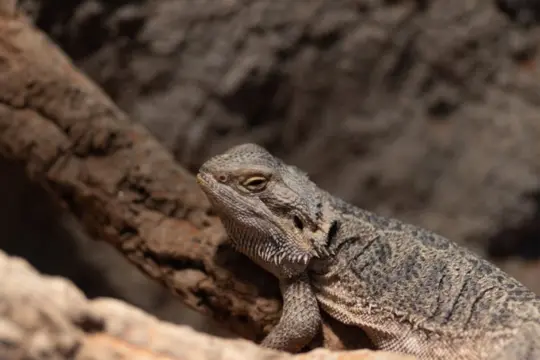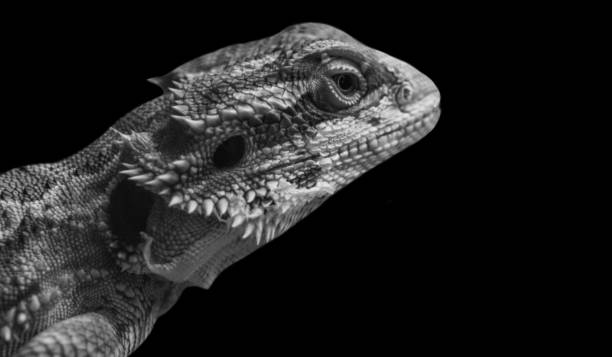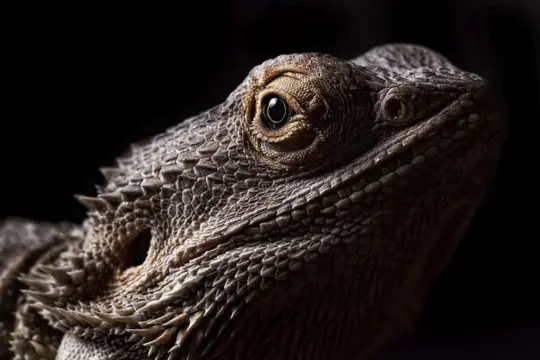Female bearded dragons are likely to turn black during the shedding process. You shouldn’t be alarmed if that’s the case, since the color change should only last for a few days. Bearded dragons may also turn black because of stress and illness, such as infections and liver diseases.
Causes of Black Coloration in Female Bearded Dragons

Female bearded dragons can turn black due to a variety of reasons. While color changes are normal in bearded dragons, blackening is often a sign of an underlying issue. Here are some common causes:
Shedding process and how it can cause temporary blackening of the skin
Bearded dragons shed their skin regularly, which is a natural process that helps them grow. During this time, they may turn black as their old skin dries and begins to flake off. This is nothing to worry about, as the color change is temporary and should only last for a few days.
To help your bearded dragon during shedding, provide them with plenty of moisture to help loosen the old skin. You can mist their enclosure daily or offer them a shallow bowl of water to soak in.
Stress-induced blackening and how to identify signs of stress in a bearded dragon
Stress can cause female bearded dragons to turn black as they try to blend in with their surroundings as a defense mechanism. Signs of stress include lethargy, lack of appetite, hiding, and aggression.
If you suspect your female bearded dragon is stressed, evaluate her environment for potential stressors such as poor lighting or temperature regulation. Make sure she has enough space and hiding spots in her enclosure.
Illnesses that can cause black coloration, such as fungal infections or liver disease
In some cases, illnesses can cause female bearded dragons to turn black. Fungal infections on the skin or toes can lead to discoloration along with other symptoms like swelling or redness around the affected area.
Liver disease may also cause darkening of the skin due to a buildup of toxins in the body. If you suspect your bearded dragon may have an illness, seek veterinary care immediately to properly diagnose and treat any issues.
Overall, black coloration in female bearded dragons can be a sign of an underlying issue. Pay close attention to your pet’s behavior and environment to catch any potential problems early and get them treated promptly.
Prevention and Treatment

Tips for preventing stress-related issues in female bearded dragons
Stress can play a major role in the health of a bearded dragon, especially when it comes to color changes. Stress-induced blackening is quite common in females and can occur due to overcrowding, improper temperatures, or inappropriate handling.
To prevent stress-related health issues, it’s important to ensure that your bearded dragon has a comfortable habitat with plenty of hiding places and basking spots. You should also minimize handling if your pet is showing signs of discomfort or anxiety.
Proper care techniques to prevent illnesses that cause blackening
Illnesses such as fungal infections or liver disease can cause black coloration in female bearded dragons. The best way to prevent these types of illnesses is by ensuring proper care techniques are followed.
This includes providing a clean environment with appropriate humidity levels, temperature gradients, and UVB light exposure. You should also ensure that your pet has access to fresh water and a balanced diet consisting of both animal protein and vegetables.
Treatment options for fungal infections or other illnesses
If you suspect that your female bearded dragon has a fungal infection or other illness-causing blackening, it’s important to seek veterinary care immediately. Treatment options may include antifungal medications or antibiotics, depending on the underlying cause of the illness. In some cases, surgery may be necessary if the condition has progressed too far.
Ultimately, prevention is key when it comes to keeping your female bearded dragon healthy and avoiding black coloration caused by stress or illness. By following proper care techniques and seeking prompt veterinary care when needed, you can ensure that your pet remains happy and healthy for years to come.
Conclusion
A Recap of Key Points About Why a Female Bearded Dragon May Turn Black
In this article, we discussed various reasons why a female bearded dragon may turn black. The shedding process, stress-induced blackening, and illnesses such as fungal infections or liver disease are some of the significant causes. We highlighted the importance of paying close attention to your pet’s behavior and color changes to catch any potential health problems early and help ensure your bearded dragon stays healthy.
Final Thoughts on the Importance of Monitoring Your Pet’s Health and Behavior
As responsible pet owners, we need to make sure our pets get the best possible care. This includes monitoring their health regularly and taking prompt action if they notice anything unusual. Keeping an eye on your bearded dragon’s behavior and color changes can help you detect signs of illness before it becomes too late.
Taking care of a pet is not always easy, but with love, dedication, and proper care techniques, you can provide your bearded dragon with a happy and healthy life. Remember that every bearded dragon is unique, so keep learning about their needs as they grow older.
With proper care and attention paid to their health needs by following preventative measures such as stress reduction techniques or regular vet check-ups for potential fungal infections or liver disease diagnosis/treatment options available through vet visitations.
